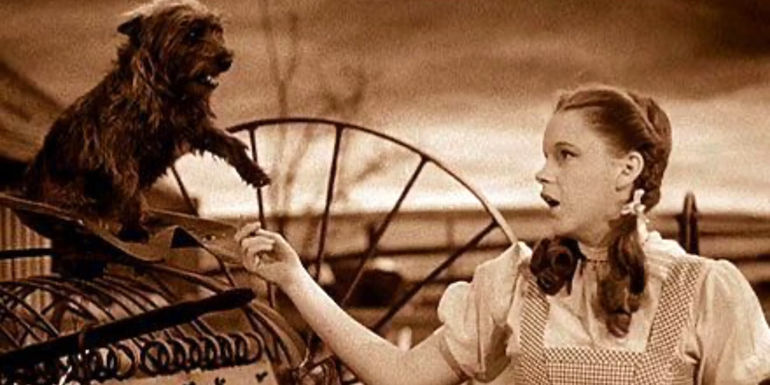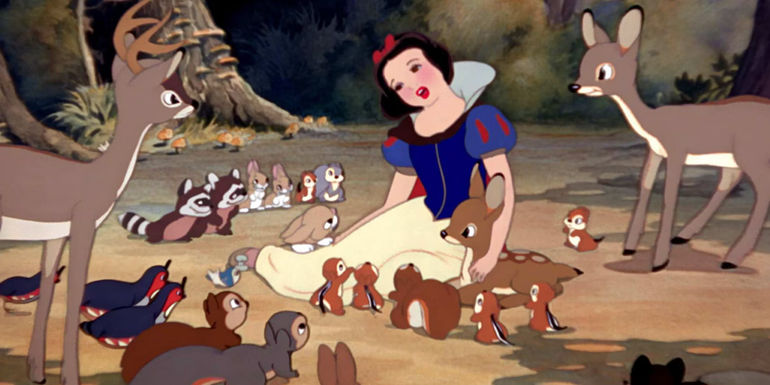
The Truth About the First Color Movies in Film History

Unveiling the pioneers of color in cinema
The Misconception of The Wizard of Oz
The classic film The Wizard of Oz revolutionized cinema with its use of color and some might mistakenly believe it to be the first color movie, but it didn't even pioneer the use of color on film. So, what was the first movie in color? The Wizard Of Oz instantly became iconic, and acclaimed for its excellent storytelling, heartfelt performances, innovative special effects, and musical score. But the element that helped the movie transcend to greatness was Technicolor, the most famous color process in Hollywood. With its highly saturated hues and completely natural representation of real-life color, the process marked the precedent for the mainstream use of color in every film that came afterward. However, it wasn't the first film in color.
A perturbed black-and-white Judy Garland as Dorothy from the Wizard of Oz, against a backdrop for the 1914 color movie The World the Flesh and the Devil
As with most innovations such as sound, special effects, and CGI, the film that popularized color is not the first color movie. It is always tricky to pinpoint the exact moment a technological advancement is born, and sometimes it is also as tricky to identify one sole creator. Which motion picture truly is the 'first movie in color' can depend on the classification criteria. When talking about feature-length, narrative-driven movies like The Wizard of Oz, there's one film that stands out as the first color movie in film history. By many measures, The Wizard Of Oz was an innovator, but there are a few color movies that came before.
Dorothy and her friends head up the Yellow Brick Road in The Wizard of Oz
The Pioneers Before The Wizard of Oz
Color films existed long before the idea for the iconic Hollywood adaptation of the Wizard of Oz book was even conceived. For those wondering if Wizard of Oz was the first color movie, the answer is a resounding no. Around 190 motion pictures experimented with some sort of color techniques before the hit movie starring Judy Garland, but unfortunately, many of them were lost. As far back as 1895, Thomas Edison was already exhibiting short hand-painted (frame by frame) non-narrative films for the Kinetoscope — a predecessor for movie projectors designed for individual viewing through a peephole window — the first and most famous of which is Annabelle's Serpentine Dance.
Dorothy wakes up in The Wizard of Oz
Even George Méliès's historic 1902 A Trip to the Moon has a hand-colored print. However, the first color movie projected in natural color (Kinemacolor) was A Visit to the Seaside, an eight-minute British short film that shows small snippets of people living their everyday lives, followed by the first feature-length silent drama using the same technique: The World, the Flesh, and the Devil. This means that the latter is actually the first non-documentary full-color feature film in history.
Dorothy speaks to Toto, in Kansas, in The Wizard of Oz.
What sets The World, The Flesh, and the Devil apart from earlier color movies like 1903's La Vie et la passion de Jésus Christ, 1912's With Our King and Queen Through India, and 1912's The Miracle is that it is a feature-length work of fiction. In addition, Kinemacolor — a color technique that served as a predecessor to the Technicolor that brought Dorothy and the Wicked Witch to life — was native to its filming process. This means that the footage was originally captured in color (with the use of red and green filters) instead of going through an artificial coloring process after the film was developed. This makes The World, The Flesh, and the Devil the first color movie, officially.
The Tinman, Lion, Dorothy, Toto, Glenda and Scarecrow in The Wizard of Oz
The Impact of The Wizard of Oz and Snow White
The reason why The Wizard of Oz is widely regarded as the first color movie is because of the effect it had on the industry. Dorothy's step into the land of Oz represented the evolution from 'Classic Hollywood,' a sepia and monochromatic environment, into a new world full of lively color and happiness. In fact, this emblematic sequence was done in a very simple yet incredibly creative way: The film was already shot in Technicolor, but the set and a stand-in for Dorothy were painted in a sepia tone. The stand-in opens the door and reveals the vibrant land of Oz, prompting Judy Garland to enter in full color.
The Scarecrow, Tinman, Dorothy, and Lion looking scared in The Wizard of Oz
The details in the costumes from The Wizard of Oz, along with its vivid sets and its graceful makeup work consequently blew everybody away in theaters. While The Wizard of Oz wasn't the first movie in color, it surely was the most influential. Every Wizard of Oz adaptation (such as Oz the Great and Powerful) has failed to compare to the original, in great part because they don't present any innovation that compares to the achievement of the 1939 film. Even by today's standards, the land of Oz continues to be a breathtaking paradise thanks to the sense of childlike wonder that its color evokes.
Snow White singing at the well in the Disney animated feature Snow White and the Seven Dwarfs
Snow White And The Seven Dwarfs Premiered In 1937. It feels almost anticlimactic to learn that Disney pioneered the film industry almost a century before Disney+, but the first Disney Princess feature Snow White and the Seven Dwarfs is the first color movie that's animated, full-length, and with sound. The interesting thing about Snow White is that this cinematic and technological breakthrough was actually coined as 'Disney's Folly,' as many believed that the endeavor would end in failure during its four-year production period.
The queen closing the curtains in Snow White
However, Snow White did quite the opposite. This ended up being one of the biggest wrong-calls in history, since today many credit the animated Disney film as the catalyst that launched Walt Disney to fame and firmly cemented his place as one of the most accomplished animators of all time. Snow White broke a lot of firsts for Disney and the industry. Snow White was the first commercially successful movie of its time, the first film with an official soundtrack, and the first movie to release said soundtrack as an album.
Snow White talking to the forest animals in Snow White and the Seven Dwarfs















